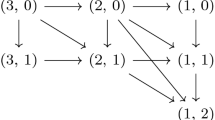Abstract
The relativistic 4-interval (X-X (0) 2=s (0)2 is interpreted as a 4-hyperboloid of radiuss (0) and center at the pointX (0)μ that is formed by particles radiated isotropically from its center with velocities 0<β≤1 whose positions in 4d spacetime are fixed at a proper times (0)/c that is the same for all of them. Therefore, the 4-hyperboloid can be regarded as a mathematical model of an isotropically radiating source, and all transformations of the spacetime variables that leave its equation invariant have a physical meaning and determine the symmetry properties of 4d spacetime. These transformations form the group of motions of a rotating 4-hyperboloid. For constant radiuss (0)=const, its configuration space is the 8-dimensional bundleR(1,3)=R(1,3) ⊗Φ(1,3), and the minimal group of motions isK=P ⊗O(1,3). It is shown that the well-known groupsP andO(1,3) are defined, respectively, only on the baseR(1,3) and only on the fiber Φ(1,3) of the spaceR(1,3) and that the symmetry properties of 4d spacetime introduced by them are incomplete. The groupK extends the isotropy property of 4d spacetime to moving frames of reference. The group of spacetime transformations is extended to the case ofN bundles. It is shown that the new interpretation of the 4-interval makes it necessary to assume that the radiuss (0) is variable. The groups of motion of a 4-hyperboloid of variable radius are constructed in the second part of the paper. They introduce new symmetry properties of 4d spacetime.
Similar content being viewed by others
References
B. G. Konopel'chenko,Fiz. Elem. Chastits At. Yadra,8, 135 (1977).
I. M. Gel'fand, R. A. Minlos, and Z. Ya. Shapiro,Representations of the Rotation and Lorentz Groups and Their Applications, Pergamon Press, Oxford (1963).
Yu. M. Shirokov,Zh. Eksp. Teor. Fiz.,33, 861, 1196, 1208 (1957).
V. I. Arnol'd,Mathematical Methods of Classical Mechanics, 2nd ed., Springer-Verlag, New York (1989).
N. P. Konopleva and V. N. Popov,Gauge Fields, Harwood, Chur (1981).
A. Pais,Group Theory and Elementary Particles [Russian translation], Mir, Moscow (1967).
V. P. Belov,Yad. Fiz.,42, 786 (1985).
Ya. P. Terletskii,Paradoxes of Relativity Theory, Plenum Press, New York (1968).
Additional information
D. V. Efremov Institute of Electrophysical Apparatus. Translated from Teoreticheskaya i Matematicheskaya Fizika, Vol. 100, No. 3, pp. 458–475, September, 1994.
Rights and permissions
About this article
Cite this article
Belov, V.P. Groups of spacetime transformations and symmetries of four-dimensional spacetime. I. Theor Math Phys 100, 1142–1153 (1994). https://doi.org/10.1007/BF01018579
Received:
Revised:
Issue Date:
DOI: https://doi.org/10.1007/BF01018579



